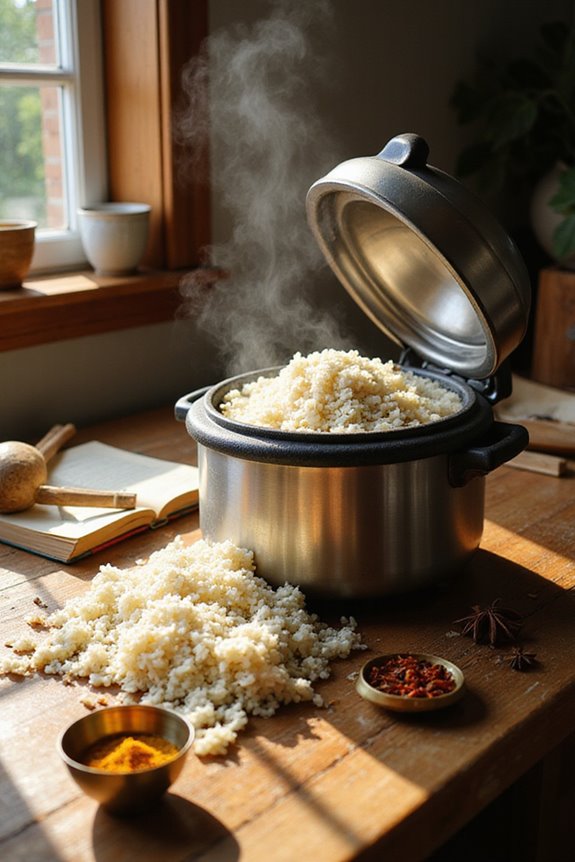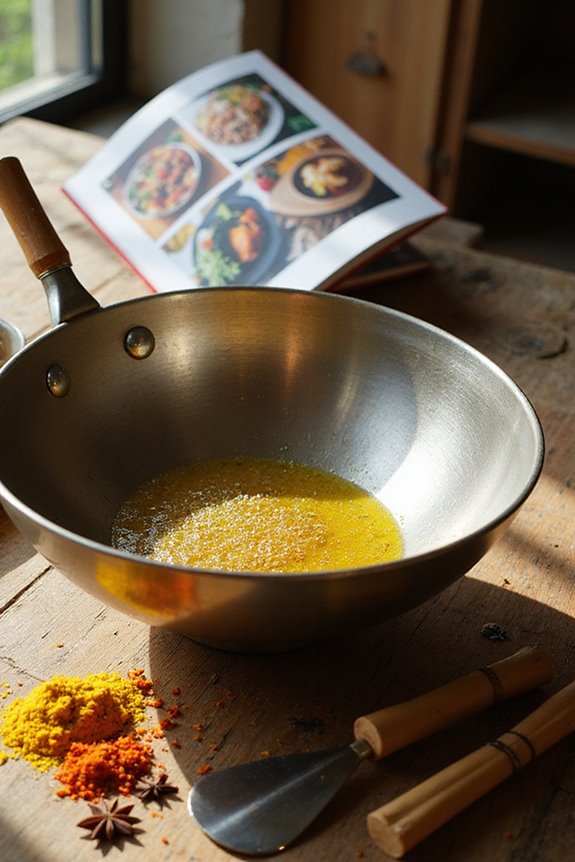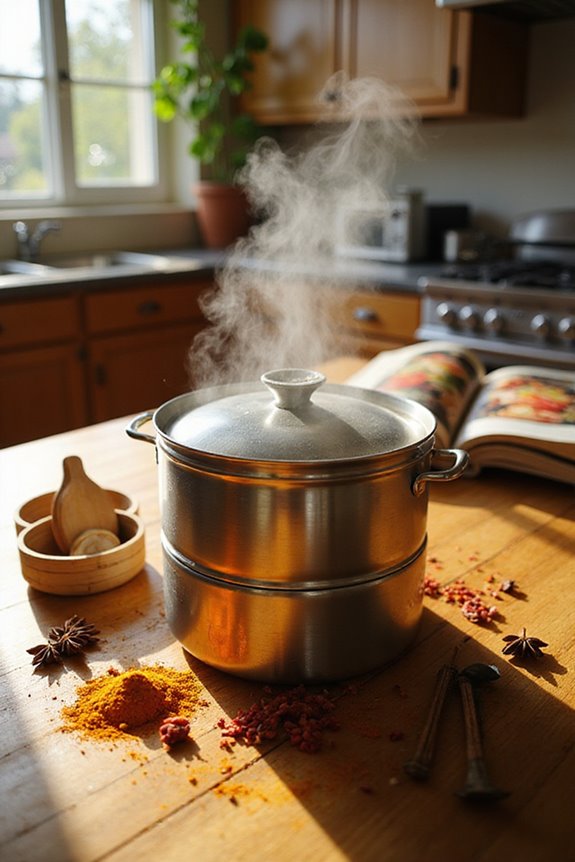To season our new mortar and pestle, let’s make it fun and easy! First, we’ll rinse it under warm water to remove any dust. Next, we fill it halfway with white rice and grind for about 15 minutes until the rice turns gray. Discard that rice, then we’ll rinse and dry our tools. For that extra flair, we can grind some spices like garlic and cumin with rock salt. Who knew seasoning could be so magical? Stick around to discover more tips!
Key Takeaways
- Start by cleaning the mortar and pestle with warm water and a soft brush to remove any dust without damaging the surface.
- Season the mortar by grinding white rice for up to 15 minutes until it turns gray, indicating effective cleaning.
- Use spices such as garlic and cumin with rock salt to create a paste, enhancing flavor and preparing the mortar for spices.
- After seasoning, rinse thoroughly with warm water, avoiding soap, and allow to air dry in a sunny spot.
- Store the pestle inside the mortar to protect it, and ensure regular care to maintain its condition and performance.
Importance of Seasoning a New Mortar and Pestle
When we first get our hands on a new mortar and pestle, we might think it’s ready to whip up culinary magic right away. But wait! Seasoning isn’t just a chore; it’s deeply rooted in historical significance and cultural practices. By seasoning our tools, we’re honoring generations of cooks who’ve perfected this step.
Here’s why seasoning is essential:
- Eliminates Residue: Removes dust and debris so our flavors sing!
- Better Safety: Prevents funky flavors and unwanted bacteria.
- Enhances Durability: Keeps our mortar and pestle in top shape for years. Additionally, it’s worth noting that the maintenance and care of cooking tools can greatly impact their longevity and performance.
Initial Cleaning Before Seasoning
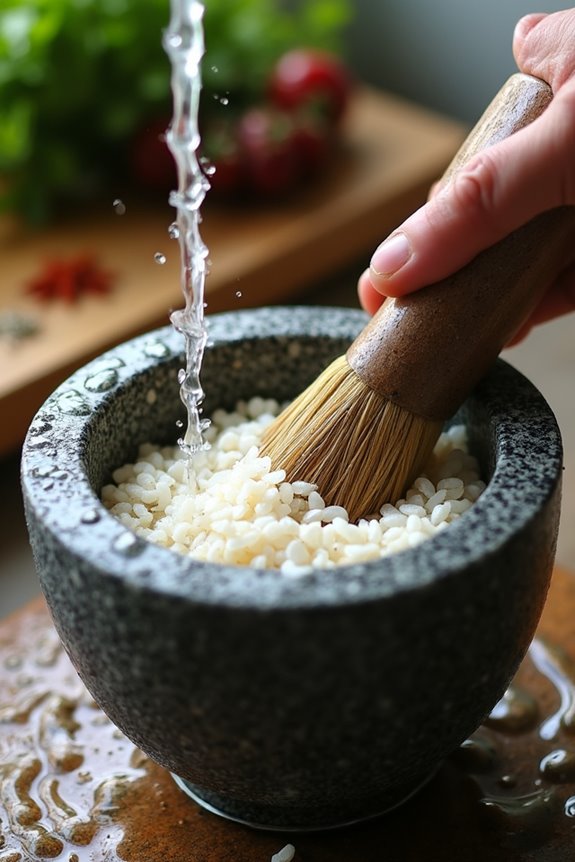
Before we plunge into the delightful process of seasoning our mortar and pestle, let’s tackle the initial cleaning—because nobody wants a surprise party of dust bunnies interrupting our culinary creations! Here are some effective methods to get us started:
- Rinse: Give your mortar and pestle a good rinse under warm water to wash away any dust and debris.
- Soft Touch: Use a soft brush or non-abrasive sponge to avoid scratching the surface.
- No Harsh Chemicals: Stay clear of acidic cleaners; we don’t want to ruin our new kitchen buddy!
- Mild Soap: For stone and ceramic, a bit of unscented dish soap can work wonders, but be gentle! Remember, proper maintenance is key to preserving the longevity of kitchen tools, much like the care required for bamboo cutting board sets.
Let’s make sure they’re sparkling clean and ready for the magic of seasoning!
Seasoning With White Rice
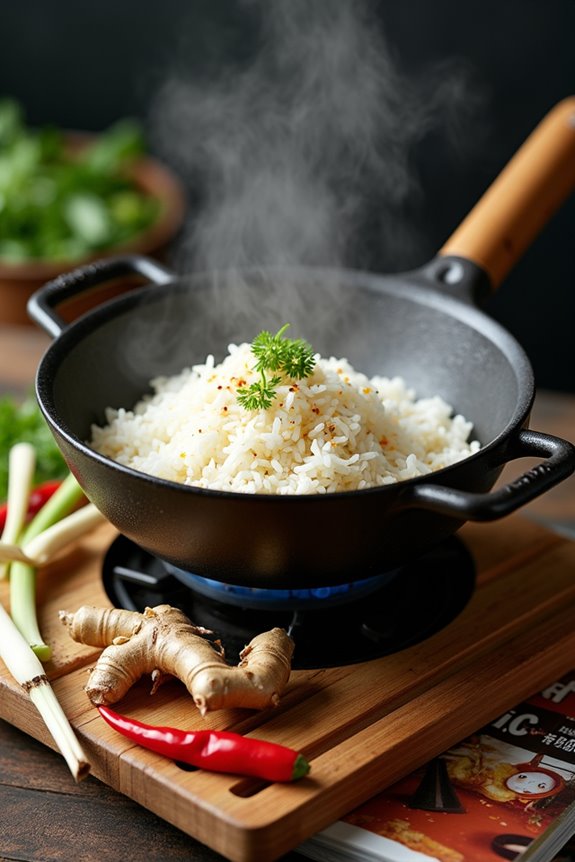
Getting our mortar and pestle ready for culinary adventures can be a delightful journey, especially when seasoning with white rice! This magical rice type is perfect for cleaning because it helps remove any pesky stone dust. Let’s fill our mortar about 1/4 to 1/2 full with rice and gently grind it using circular motions. We’ll want to grind for up to 15 minutes until the rice turns gray before transforming back to pure white. This tells us we’ve successfully banished any debris!
Once done, we’ll discard the rice, rinse our tools with warm water, and let everything air dry. Doing this guarantees our mortar is ready for flavorful spices later! Additionally, using tools made from bamboo utensils can enhance your cooking experience by providing non-scratch properties and strength. Happy grinding, friends!
Seasoning With Spices and Aromatics

Once we’ve got our mortar and pestle sparkling clean from that magical white rice treatment, it’s time to flavor them up with some spices and aromatics! Pick your spice selection wisely—think garlic, cumin, black pepper, and rock salt. We’ll create a delightful paste that enhances our dishes’ flavors.
- Grind garlic and cumin seeds together with rock salt until you get a smooth paste.
- Rinse the mortar and let it dry.
This seasoning process doesn’t just boost flavor; it guarantees an aromatic balance and prevents our ingredients from mixing unwanted flavors. Additionally, using herbs like ginger and garlic can provide anti-inflammatory properties that elevate dish healthiness. If your mortar still feels rough, don’t hesitate to repeat this process! Let’s make our meals sing with that extra oomph!
Grinding Technique and Handling Tips
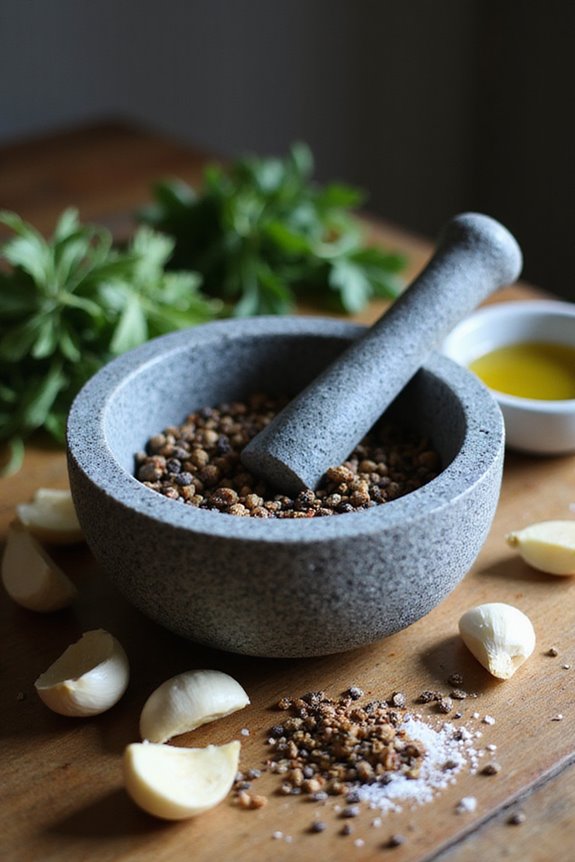
Let’s plunge into the delightful world of grinding! This magical process allows us to release the rich flavors of our ingredients. To get started, we should apply gentle grinding pressure, letting the pestle’s weight do most of the work. Using a steady pestle grip, we can create a consistent circular or back-and-forth motion for even results.
- Begin with coarse materials like uncooked white rice to smooth the surface.
- Avoid pounding or tapping, which could lead to cracks—no one wants a broken mortar during holiday festivities!
- Always keep the mortar dry to prevent slipping and maintain control. Additionally, the surface should be knife-friendly to ensure that the ingredients are ground without damage to your utensils.
Post-Seasoning Care and Readiness
Caring for our mortar and pestle after seasoning is just as essential as the seasoning process itself! For delightful post-use cleaning, we’ll want to rinse it thoroughly in warm water—no soap, please! Soap can sneak into those porous surfaces and spoil our magic. Discard any leftover rice or seasoning, then gently scrub away any debris with a soft brush.
Next, let’s guarantee our mortar and pestle are completely dry by air-drying in a sunny spot—this helps keep those pesky bacteria away! For proper storage, tuck the pestle inside the mortar to protect it and avoid stacking anything on top. Additionally, ensure that you invest in high-grade materials for your kitchen tools, as this will enhance their durability and performance. With these tips, our seasoned tools will stay fresh, ready, and vibrant for our culinary adventures!
Common Mistakes to Avoid
When seasoning a mortar and pestle, it’s easy to overlook some common pitfalls that can turn our delightful kitchen tool into a flop. Avoid these seasoning errors:
- Don’t Rush: If we don’t grind rice until it’s a white powder, we risk missing essential seasoning.
- Clean Carefully: Missing dust and debris makes our seasoning less effective.
- Oil Smart: An uneven oil application can overwhelm the mortar’s surface.
Preparation mistakes are just as sneaky:
- Order Matters: Always add dry ingredients before wet ones to prevent gumming!
- Technique Counts: Remember to use a circular motion, not a pounding style.
Benefits of a Well-Seasoned Mortar and Pestle
A well-seasoned mortar and pestle can transform our cooking experience into something truly magical! With proper seasoning, we reveal amazing benefits that make our culinary adventures more enjoyable.
- Flavor Enhancement: When we crush ingredients, we release flavors and aromas that simply cutting can’t match.
- Texture Control: It gives us precise control over the consistency of everything from guacamole to pesto.
Plus, the delightful scent of spices and garlic lingers, enhancing our future dishes! By investing a little time into this one-time seasoning process, we guarantee our mortar and pestle becomes a go-to tool in our kitchens. So let’s roll up our sleeves, embrace the magic, and make our cooking truly flavorful and textured! 🎉
Frequently Asked Questions
Can I Season My Mortar and Pestle With Vegetables or Fruits?
We believe vegetable seasoning and fruit grinding aren’t ideal for our mortar and pestle. They could leave unwanted flavors and moisture, potentially damaging our cherished tools. Let’s stick to traditional methods for the best results!
How Long Does the Seasoning Process Take in Total?
When we think about the seasoning timeline, we’re looking at a total of 60 to 120 minutes. Let’s embrace the time requirements together—it’s worth achieving that perfect, clean flavor in our kitchen!
Can I Use Soap When Cleaning After Seasoning?
As we navigate the culinary seas together, let’s steer clear of soap residue after seasoning. Instead, gentle cleaning methods—just warm water and a brush—will help our mortar and pestle retain their flavorful secrets.
Is Seasoning Necessary for Non-Stick or Ceramic Mortars?
When it comes to seasoning non-stick or ceramic mortars, we find it’s unnecessary. Non-stick benefits keep food from sticking, while ceramic durability guarantees they remain intact without added seasoning. Let’s embrace their convenience and simplicity together!
How Can I Tell if My Mortar Is Fully Seasoned?
Feeling like culinary wizards, we can tell our mortar’s fully seasoned by spotting smooth texture, darker color, and no gritty residue. If grinding’s a breeze, we’ve revealed the incredible seasoning signs. Let’s keep creating magic together!


